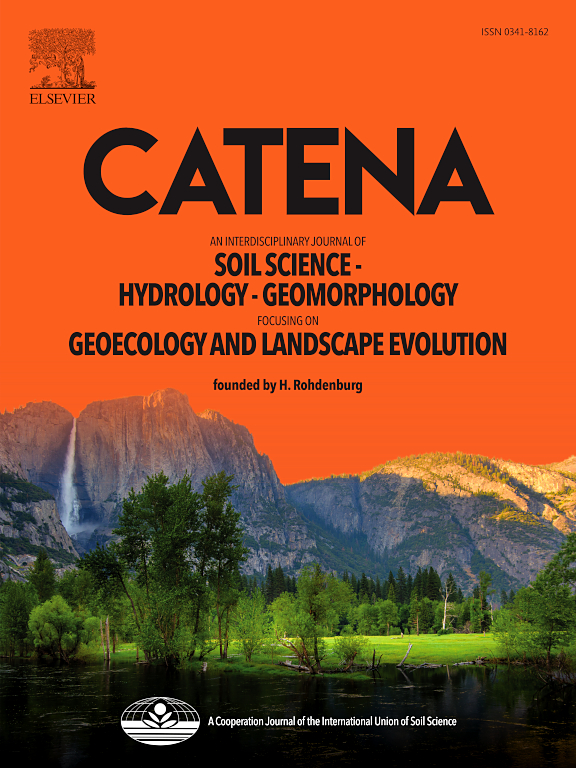植被类型的变化改变了岩溶槽谷侵蚀和沉积地形下的土壤呼吸作用
IF 5.4
1区 农林科学
Q1 GEOSCIENCES, MULTIDISCIPLINARY
引用次数: 0
摘要
土壤呼吸是陆地生态系统碳循环的重要组成部分,受到土壤侵蚀和沉积地形的显著影响。然而,侵蚀和沉积地形对土壤呼吸的影响尚不清楚,特别是在不同植被类型的喀斯特山谷中。因此,我们选择了5种植被类型(撂荒地(杂草稀疏的裸露土壤)、草地、坡耕地(玉米田)、灌丛和森林),进行了原位监测,研究了植被类型和侵蚀沉积地形对土壤呼吸的影响。此外,还建立了结构方程模型来识别关键驱动因素。结果表明:1)侵蚀场地的环境因子、土壤有机碳含量、土壤含水量(SWC)、土壤温度(ST)和电导率(EC)显著大于沉积场地。2)侵蚀场地的土壤呼吸速率高于沉积场地,森林土壤呼吸速率最高的是反倾斜斜坡(11.2µmol·m−2·s−1),其次是谷陷和倾斜斜坡。土壤呼吸速率在8月达到峰值3.15µmol·m−2·s−1,1月最低,为0.27µmol·m−2·s−1。3)土壤呼吸速率与土壤温度呈指数增长关系。此外,土壤温度和土壤有机碳含量对土壤呼吸的直接影响显著,路径系数分别为0.71和0.25,而侵蚀和沉积地形和植被类型对土壤呼吸有间接影响。研究结果揭示了侵蚀沉积地形和植被类型对喀斯特槽谷土壤呼吸的影响,为提高喀斯特槽谷生态系统碳储量和调节碳循环提供了理论依据。本文章由计算机程序翻译,如有差异,请以英文原文为准。
Changes in vegetation types alter soil respiration under the erosion and deposition topography in karst trough valley
Soil respiration is a critical component of the terrestrial ecosystem carbon cycle and is significantly influenced by soil erosion and deposition topography. However, the effects of erosion and deposition topography on soil respiration remain unclear, particularly within karst valleys with different vegetation types. Therefore, we selected five vegetation types (abandoned land (bare soil with sparse weed), grassland, sloping farmland (corn field), brushland, and forest) and conducted in situ monitoring to examine the impacts of vegetation types and erosion-deposition topography on soil respiration. Additionally, a structural equation model was developed to identify key driving factors. The results indicated the following. 1) The environmental factors, soil organic carbon content, soil water content (SWC), soil temperature (ST), and electrical conductivity (EC) at the erosion site are significantly greater than those at the deposition site. 2) The soil respiration rate at the erosion site was higher than that at the deposition site with the anti-dip slope showing the highest soil respiration rate (11.2 µmol·m−2·s−1) in the forest, followed by the valley depression and the dip slope. The average soil respiration rate peaked at 3.15 µmol·m−2·s−1 in August and reached the lowest value of 0.27 µmol·m−2·s−1 in January. 3) The relationship between the soil respiration rate and soil temperature exhibited an exponential increase. Additionally, the soil temperature and soil organic carbon content had significant direct effects on soil respiration with path coefficients of 0.71 and 0.25, respectively, whereas erosion and deposition topography and vegetation type had indirect effects. Our findings highlight the effects of erosion and deposition topographies and vegetation types on soil respiration in the karst trough valleys and provide a theoretical foundation for enhancing carbon storage and regulating the carbon cycle in the karst trough valley ecosystems.
求助全文
通过发布文献求助,成功后即可免费获取论文全文。
去求助
来源期刊

Catena
环境科学-地球科学综合
CiteScore
10.50
自引率
9.70%
发文量
816
审稿时长
54 days
期刊介绍:
Catena publishes papers describing original field and laboratory investigations and reviews on geoecology and landscape evolution with emphasis on interdisciplinary aspects of soil science, hydrology and geomorphology. It aims to disseminate new knowledge and foster better understanding of the physical environment, of evolutionary sequences that have resulted in past and current landscapes, and of the natural processes that are likely to determine the fate of our terrestrial environment.
Papers within any one of the above topics are welcome provided they are of sufficiently wide interest and relevance.
 求助内容:
求助内容: 应助结果提醒方式:
应助结果提醒方式:


